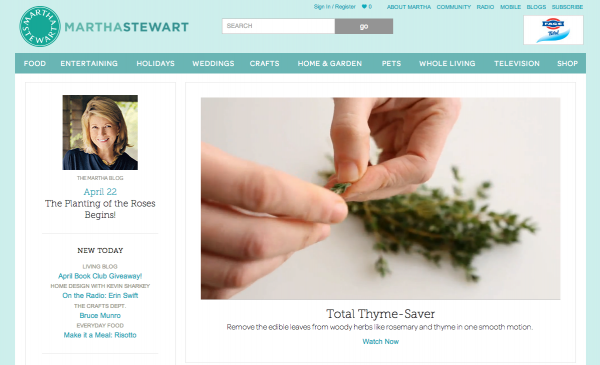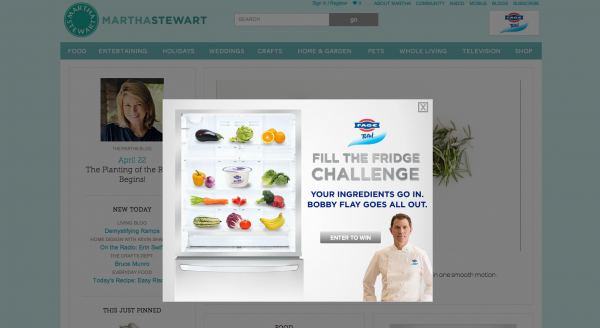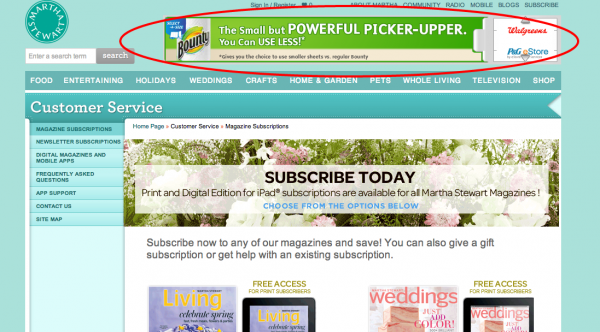Everyone loves Martha Stewart – at least her free content

Today, before I dive into subscription website publishing, I’d like to give a shout-out to the Boston Globe for dropping its paywall throughout the Boston Marathon crisis. I doubt that anyone from the Globe will read this blog, but at least Mequoda’s readers from all around the world can appreciate this act of community service.
In fact, after the experience of the Marathon crisis last Monday, the Globe added a live blog to its site that is available to all readers, including non-subscribers.
The Globe erected its paywall in September 2011. By contrast, the subject of today’s post, MarthaStewart.com, presumably because of its enormous brand recognition among consumers and the advertising that surely flocks to its pages, has no need of a paywall.
Or does it?
All roads lead to Martha
How big is the Martha Stewart brand? The formal name, Martha Stewart Living Omnimedia, pretty much says it all. And Googling the name for news of the company in the media world delivers stunning results.
Page 1 of Google results delivered nine listings from the website itself, and the usual listing from Wikipedia. One the second page, I found several news articles about its decision to fold two of its four magazines into the flagship product. More on that later … but more interestingly, I couldn’t find a single other search result that wasn’t from the website itself or from subscription retailers like Amazon … and I finally gave up on Page 9.
In short, Martha Stewart Living owns its own name in Google search, which is to say, on the Internet. I’ve never seen that kind of result when Googling any other publication. If there are any other references to the company on the Internet, they can’t compete with the company’s optimization of every single page for organic search and every magazine outlet that sells the magazine!
No matter what your goal in Googling Martha, you’re going to be driven to Martha Stewart content or to a subscription purchase page. This is surely unprecedented subscription website publishing.
But what would the goal be in driving traffic to the MS website if there’s no paywall? Perhaps there are lots of incentives to subscribe, or at least hand over your email address for something free, so that MSL Omnimedia can market its paid products to you – the heart of the Mequoda Method?
If you thought there must be something at the website that allows monetization of the Stewart brand, you’d be wrong.
It’s all about the eyeballs
As one would expect, MarthaStewart.com is a lush, beautifully-designed website, with an abundance of soothing white space and a tasteful color scheme. Everywhere you look you see gorgeous images of food, home décor, and artistic crafts. If you’re part of the Martha Stewart target audience, you can spend hours here.
The tabs lead to content on food, entertaining, holidays, weddings, crafts, home & garden, pets, whole living, television and the store. Every bit of all this content is free – recipes, craft projects, wedding dress gallery, all of it.
There’s a regularly updated blog – but I confess I can’t tell you exactly how often the company updates it because there are actually 21 blogs covering all of Martha’s topics, all of them updated once or twice a day, some of them more often, some less. It’s an astonishing amount of new content.
None of the magazine content appears to be made available for free. However, you actually have to search to find any kind of call to action for the two magazines remaining in the empire – Martha Stewart Living and Martha Stewart Weddings. The largest, a standard right rail advertisement, appears on the home page … below editorial content and an ad for the March of Dimes
Perhaps this is all part of the “curation” subscription website publishing business model – presuming that visitors will be so overwhelmed by the free content that they’ll gratefully seek out and pay for a nice, neat, curated magazine.
Or is it simply hubris? Is MSL Omnimedia carefully monitoring rising revenues that prove this strategy is working, or is the company simply supremely confident that the name and the lavish content will magically convert passing visitors all by themselves?
A blog of this size isn’t going to get the attention of anyone at a company named “omnimedia” who could answer these questions. But what is certain is that advertising, not subscriptions, is a huge part of their revenue strategy.
With thousands of pages of content, there’s ample room for ads. The site utilizes one of Mequoda’s favorite advertising strategies, the floater, to great effect – though Mequoda clients use their floaters to promote their own products, while MS floaters come from advertisers such as Fage, Bounty, Panera and Kohler.

In fact, MarthaStewart.com loves floaters so much, they’ve sold space on their subscription page! Now that’s confidence – MS is willing to risk losing a potential subscriber to a company that makes paper towels!

Another fascinating thing to note: All videos are free, but you cannot access a single one of them until you’ve sat through an advertising video. All the thumbnails sit there, just below the Kitchenaid video, tantalizing but greyed out and untouchable. You can’t even fast forward the ad. You just … have … to … wait.
Clearly MSL Omnimedia is relying on the eyeballs it can deliver to advertisers to drive profits. And as we’ve seen, MarthaStewart.com employs Mequoda strategies to a certain degree. Incredibly optimized for search? Check. Free content? Check. Blog? Check. Forums to build relationships with visitors? Check. These things will drive advertising revenues, if not subscription revenues. It must be working for Martha, right?
Maybe ….
How not to survive a recession
While it’s tempting to assume MSL Omnimedia knows exactly what it’s doing, based simply on the awesome success of Ms. Stewart, media watchers know it’s not exactly going the way you’d think for the company. Back in November 2012, the company announced that in addition to laying off 12 percent of its staff, it would respond to declines in advertising revenue by folding one of its four publications, Martha Stewart Everyday Food, into the flagship publication.
A 2004 acquisition, Whole Living Magazine, would be put up for sale. In the end there were no takers, and Whole Living has also been folded into MSL.
That leaves MSL itself and MSL Weddings as the only remaining publications in the stable. As the New York Times noted:
The company’s publishing fortunes now rest heavily on magazines with very mixed results. Martha Stewart Living’s advertising pages declined by 30 percent in the first half of the year, according to data tracked by the Publishers Information Bureau. While its overall circulation has grown slightly, its newsstand sales dropped in the last year to 163,571 copies in June from 198,700 copies the same time the year before, according to the Audit Bureau of Circulations.
And while MSL.com’s Online Media Index is a reasonable 1.66, showing that the site is pulling in more visitors for free content than it has paid circulation, it’s still not what we’d call healthy for a publication that’s losing advertising revenues, eliminating premium product and cutting staff.
If you can’t attract vastly more traffic to a free website, even with the Martha Stewart name attached, than you can attract paid consumers, something’s wrong with your audience development program.
And if advertising and newsstand sales aren’t cutting it, that leaves premium content to improve the bottom line. MSL.com has plenty of that, but it needs website traffic of three times its paid circ or more – as several other large consumer publications have – and it needs to put more effort into converting them into paying customers.
Perhaps there’s just too much media in Martha Stewart Living Omnimedia, and the magazine side of the business is being overlooked, as has happened at TIME magazine. Whatever the problem, Martha won’t continue to be a publishing diva forever at this rate.
It leaves me wondering … is it time for a paywall at MarthaStewart.com? Or will we be reading about more layoffs and content cutbacks in the future for this omnimedia company? What do you think?


